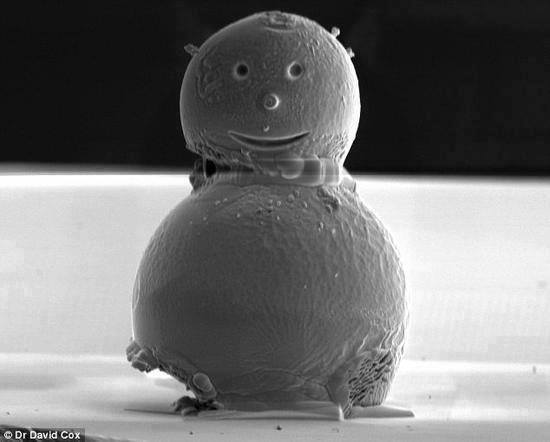
At just 10 µm (0.01 millimeters) across, this little guy is only 1/5th the width of a human hair. It was created in 2009 by Dr. David Cox at the National Physical Laboratory (NPL) in the UK. This minuscule masterpiece showcased the advanced techniques of nanofabrication available to researchers.
The snowman’s body comprises two tin beads, each incredibly small, that are normally used to calibrate electron microscope lenses. These beads were meticulously welded together using a minute amount of platinum. Platinum, a precious metal known for its durability and resistance to corrosion, provided a sturdy bond essential for the snowman’s structure.
To add the finer details, such as the eyes and the smile, Dr. Cox employed a focused ion beam (FIB). This technique involves directing a stream of ions at a material to sculpt it with nanometer precision. The FIB carved out the snowman’s facial features with astounding accuracy. Finally, a tiny blob of platinum, less than one micrometer wide, was deposited to form the nose.
While the snowman itself was little more than a cute example of scientific creativity, the techniques used to create it have far-reaching implications. Nanofabrication methods like those employed by Dr. Cox are very useful in fields like electronics and medicine.
In electronics, the ability to manipulate materials at the nanoscale has led to the development of smaller, more efficient components. Transistors, the building blocks of modern electronics, have benefited from nanofabrication techniques, allowing for the production of faster and more powerful processors. In medicine, nanotechnology is paving the way for revolutionary treatments and diagnostics. Nanoparticles can be engineered to deliver drugs directly to cancer cells, minimizing damage to healthy tissue. Additionally, nanofabrication techniques are used to create highly sensitive diagnostic devices capable of detecting diseases at early stages. So while this snowman isn’t doing much on its own, it’s a symbol of how much we can accomplish nowadays.
Ultimately, the ability to manipulate matter at such a small scale will undoubtedly lead to breakthroughs we can scarcely imagine today.


